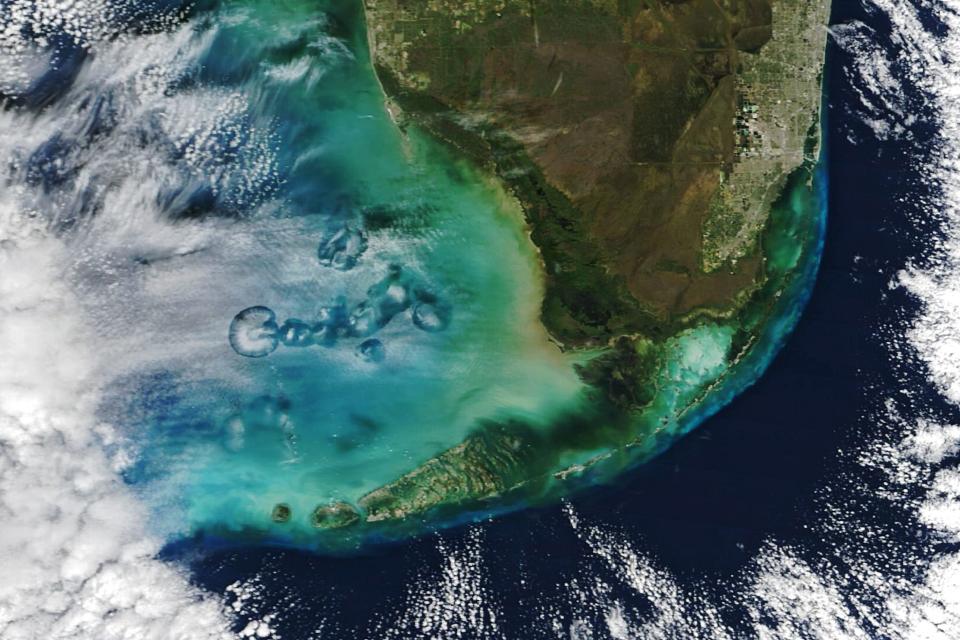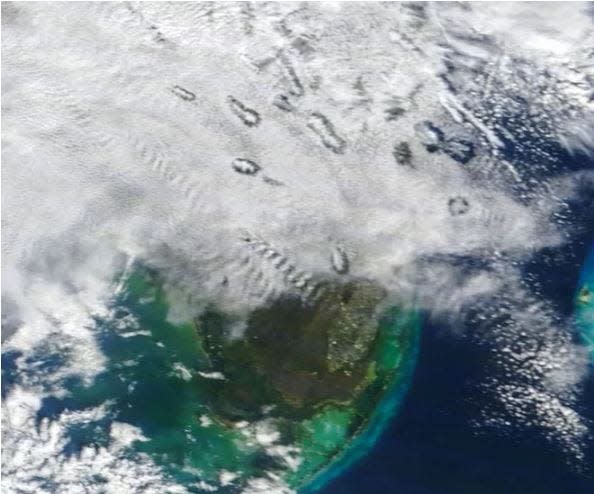NASA highlights unusual holes in sky near South Florida called fallstreak holes
They appeared in late January over the southwestern Gulf of Mexico like sinkholes in the sky, or crop circles in clouds of cotton or floating glazed donuts. NASA took note; so did some Florida Keys fishermen.
“What is going on here?” one said in a video posted on social media.
Captured on NASA’s Terra satellite and by the perplexed boaters were cavum clouds, more commonly known as "fallstreak holes” or “hole-punch clouds.”
It’s unclear if the satellite image from Jan. 30 and the video posted the next day to social media by BlacktipH Fishing are of the same clouds, but the post mentions the video was taken in the Gulf of Mexico off Key West. BlacktipH Fishing couldn't be reached for this story.

NASA Earth Observatory senior science writer Adam Voiland wrote about the satellite photo in a post last month for NASA’s Image of the Day website.
The unusual potholes in the sky happen when airplanes fly through fluffy, mid-level altocumulus clouds that contain supercooled water droplets. The droplets remain in liquid form even in freezing temperatures because they are incredibly pure, without contaminants such as dust, pollen or bacteria that ice crystals typically form around, Voiland said.
But when the air is disturbed by a plane’s wings or propellers, its temperature can drop further, pushing the supercooled droplets to freeze and ice crystals to form.
“The ice crystals eventually grow heavy enough that they begin to fall out of the sky, leaving a void in the cloud layer,” Voiland said. “The falling ice crystals are often visible in the center of the holes as wispy trails of precipitation that never reach the ground.”
Those aren't UFOs: South Florida radar picks up something beautiful, ghostly and unusual
National Weather Service meteorologist Bryce Tanner, who is based in Key West, said fallstreak holes are more likely to happen during winter in the subtropics because they need mid- to high-level clouds that are common during the cooler months.
The freezing level in the atmosphere is also lower in the winter, meaning the holes would be easier to see from someone on the ground.

Meteorologists have noted the strange holes in clouds in publications dating to the 1940s. A picture published in a 1968 edition of Weatherwise magazine of a fallstreak was titled "Hole-in-cloud: A meteorological whodunit?" Airplanes were long thought to contribute to the formations.
In 2010 and 2011, studies by scientists at the University Corporation for Atmospheric Research and NASA’s Langley Research Center directly linked the holes to passing airplanes and the supercooled water droplets freezing. They also found that elongated holes, dubbed “canal clouds,” can occur if a plane passes through the cloud at a shallow angle.
“With more than 1,000 flights arriving at Miami International Airport each day, there are many opportunities for planes to encounter the atmospheric conditions needed to produce cavum clouds,” Voiland wrote.
Kimberly Miller is a veteran journalist for The Palm Beach Post, part of the USA Today Network of Florida. She covers real estate and how growth affects South Florida's environment. Subscribe to The Dirt for a weekly real estate roundup. If you have news tips, please send them to kmiller@pbpost.com. Help support our local journalism: Subscribe today.
This article originally appeared on Palm Beach Post: Holes in clouds in South Florida: cavum clouds called 'fallstreak holes'

